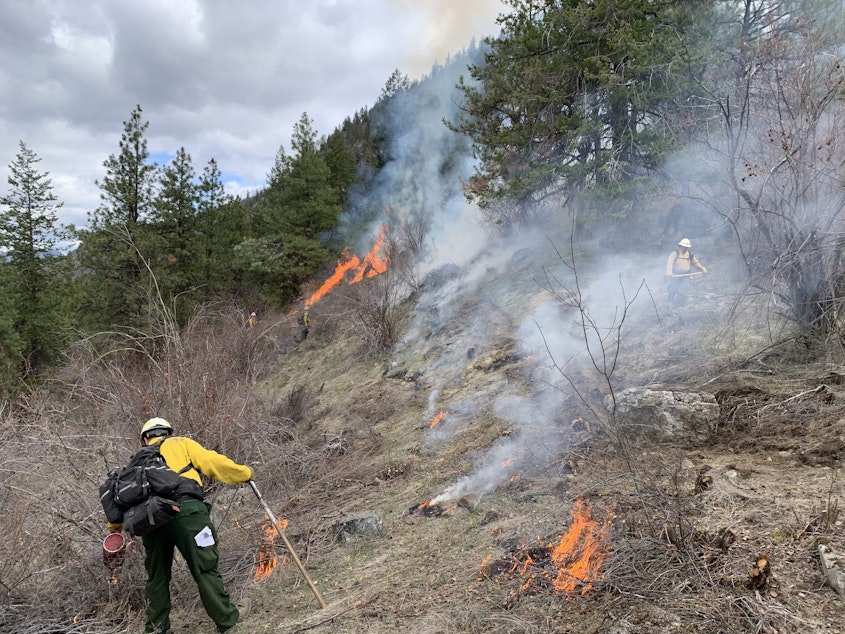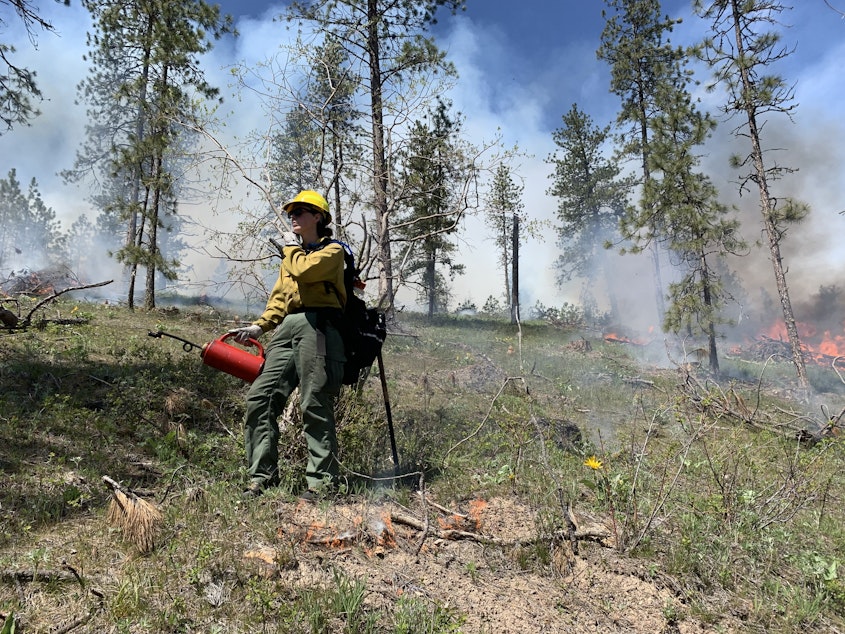Prescribed burns are back in Washington state. Why?

Washington state is conducting a prescribed burn season on state land for the first time in about 18 years.
State officials had previously halted them because of new smoke policies aimed at protecting our air quality. But now, severe wildfires are increasingly common, affecting not only air quality but also large swaths of land that are destroyed in the wake of so-called megafires.
Commissioner of Public Lands Hilary Franz says prescribed burns could help fend off that threat.
"We've had this understanding that fire was bad and that it is dangerous, not only for humans but also very dangerous for our forests. And that's not the case," Franz says. "Fire is very good for our forests, as long as our forests are in a healthy state."
That's the key: The forests have to be healthy to begin with. In other words, they need to be clear of excess debris, like dead and dying diseased trees, that add fuel to raging wildfires.
According to the Washington State Department of Natural Resources, prescribed fires have been used to treat about 65,000 acres in eastern Washington since 2017, mostly on U.S. Forest Service-managed land. Those fires were pile burns, though, which are different from the kind of burning the state is bringing back. Firefighters will now be using broadcast burns, which are controlled fires spread in areas with too much natural fuel. Broadcast burns are what people typically associate with prescribed burning.
DNR has tried to prevent potential fuel from building up even without fire, but Franz says it hasn't been enough. The result: about 1,800 fires that burned more than 600,000 acres in 2021 alone; 2020 was even worse, with more than 800,000 acres burned, in part because of the Labor Day firestorm that ravaged the town of Malden.
Franz says prescribed burning will reduce some of the fuel on our forest floors that can turn a fire from bad to worse; debris can cause fires to burn hotter and faster, she explains, and that contributes to the amount of smoke and air pollution the region has experienced in the last few fire seasons.
A 2022 report from the American Lung Association shows five Washington cities were among the top 25 with the worst short-term particle pollution, which is tied to wildfires. The Seattle-Tacoma area, for example, came in 16th on the list.
But, while prescribed burn seasons were paused to prevent air pollution, their return could actually reduce it over time.
"The more we can reduce that fuel load, the less catastrophic fires we'll have, the less smoke we will have," Franz says.
DNR firefighters have already conducted two prescribed burns this year, in the Sinlahekin Wildlife Area in March and near Springdale in May. More are on the way, though they may not come until the fall because of an especially wet April and rainy start to May.
Sponsored
Much of the state is still experiencing drought conditions, though, which add to wildfire risk in the hotter, drier months.
"Eighty percent of our fires are started by humans," Franz cautions, with or without prescribed burning. "People need to realize that the landscape throughout the state is drying sooner and staying drier longer, which makes it more prone to fires."

2021 VS 2022
Here's the good news: This year's fire season is already off to a slower start than in 2021.
Franz says there were more than 200 fires in April 2021 alone, an unprecedented number what one of the state's wetter months. This year, there were just about 45 fires in April.
"That doesn't mean we're out of the clear," she adds. "We will likely see [drier, more fire-prone conditions] as we move into June and July... [and] we'll see an increased number of fires."
The more we get, the shorter the fire season is likely to be. But there is a downside to all the rain Washington has had so far this year, too.
Franz says more rain yields longer grasses, which then turns to fuel for fires when they dry out around July and August.
It's a complicated system — one that requires humans to work with more closely with nature.
Sponsored
"Unfortunately, for the past 25-plus years, our forests have not been in a healthy state," Franz says. "And it's now our responsibility to get them there, so they can fight these fires on their own."
CRITICAL FOR 'OUR BEARS, OUR BIRDS, AND OUR SALMON'
While forests and wildlife have lived with fire long before humans got involved, increasingly devastating fire seasons have left a mark on them, too.
Consider the prescribed burn near Springdale earlier this month. The Spokesman-Review reports that will help ponderosa pines that actually need fire to maintain the natural order of things. Andrew Stenbeck, a regional manager with DNR, told the paper more Douglas fir have grown in the area because it's missed about 10 low-intensity fires over the years.
Sponsored
So, when DNR firefighters begin the work of prescribed burning in an area, they're not only considering the safety of nearby communities but also the critical species that depend on the forests.
"We know that when fire is burning at the intensity and the size and the pace and scale that we've seen, these 100,000-plus-acre fires, it destroys everything in its way," Franz says. "Not only our homes and our communities but also the critical fish and wildlife that depend on it. Our bears, our birds and our salmon."
Prescribed burns give DNR the chance to take those forest residents into consideration and do what they can to protect them.
Franz saw this for herself recently in Skamania County, where DNR workers were removing diseased trees and thinning out smaller forest growth. As they worked, they came across a mama bear and her two cubs in a small den she'd dug under a tree. The workers were then able to work around the burrowed family to keep their den protected from fire.

Franz recalls two black bear cubs who were not so lucky last year.
The pair suffered burns on their paws in the Twenty-Five Mile Fire near Lake Chelan and the Cedar Creek Fire near Winthrop. The burns turned the pads of their toes a bright, angry red.
"This is the hard part: Some people are afraid of ... prescribed fire and smoke in the air," Franz says. "My belief is the more we can control it on our terms and on our time ... [the impacts] are going to be far more beneficial than if we don't do anything."





